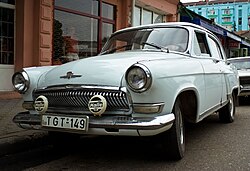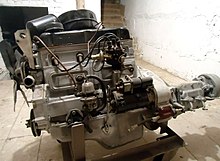GAZ M-21 Volga
| Volga | |
|---|---|
|
GAZ M-21 in Georgia (2007)
|
|
| GAZ M-21 | |
| Sales designation: | ГАЗ М-21 "Волга" |
| Production period: | 1956-1970 |
| Class : | upper middle class |
| Body versions : | Limousine , station wagon |
| Engines: |
Otto engine : 2.5 liters (55 kW) |
| Length: | 4830 mm |
| Width: | 1800 mm |
| Height: | 1620 mm |
| Wheelbase : | 2700 mm |
| Empty weight : | 1400 kg |
| Previous model | GAZ-M20 Pobeda |
| successor | GAZ-24 Volga |
The GAZ M-21 ( Russian ГАЗ М-21 , from 1965 GAZ-21 ) from the Soviet manufacturer GAZ from Gorki (now Nizhny Novgorod) replaced the GAZ-M20 Pobeda in 1956 and was built until 1968. It was the first car with the brand name Volga (Russian "Волга"). Some assemblies were taken over from the predecessor. A few modifications and a station wagon M-22 followed .
history
The car was presented for the first time in 1955. At first there were some technically different pilot series (M-21G, M-21B, M-21A, M-21W) before uniform series production began in 1957. The vehicle was originally referred to as a mid- range car , but according to the current classification, it is more of the upper mid-range . The pontoon body of the M-21 differed significantly from the hump shape of the Pobeda and followed design trends of the time. References to the fast-paced American style are unmistakable. Already at the beginning of the 1960s, the M-21 was visually no longer in keeping with the times, only the front section was slightly redesigned. Technically too, there was largely a standstill in development. Originally it was planned to equip the Volga with an automatic transmission , which was also developed and published. In fact, it stayed with the manual gearshift. A relevant modernization only took place in 1962, when the suspension was improved by modified telescopic shock absorbers and the engine output was increased from 70 to 75 hp by changing the carburettor . Externally, there was a slight modernization, especially in the area of the front end. At the same time, the combination version M-22 was added to the range. In the GDR , the Volga M-21 was mostly used as a government vehicle or taxi , while in the Soviet Union it was often bought privately. The export also took place in western countries. The M-21 found customers mainly in the Scandinavian countries . Due to its robust construction, the vehicle can still be found occasionally in everyday use, especially in the southern regions of the former Soviet Union.
The RAF-977 minibus from the Riga bus factory uses the chassis and drive of the GAZ M-21 Volga and was built until 1976.
technology
The large-stroke four-cylinder petrol engine with hanging valves was considerably more modern and powerful than that of the Pobeda. A compression ratio of only 6.6 was chosen to ensure durability on the one hand and low demands on the quality of the petrol on the other. In terms of mileage, this resulted in quite high fuel consumption of 12 to 14 l / 100 km, which, however, played a subordinate role in the Soviet Union due to the low gasoline prices. The gearbox only had 3 gears, which was sufficient for the extremely flexible engine, which allowed a very “lazy shifting” driving style. The gear lever was located on the steering column . The front bench seat was continuous and adjustable both in height and lengthways; the backrest could only be folded down completely. After the vehicle was redesigned in the early 1960s, the incline of the backrest could be gradually adjusted. Like most vehicles of the USSR, the Volga M-21 also had a large ground clearance of around 20 cm in order to be adapted to the nature of the roads there. Later, due to the high fuel consumption in Belgium, Scaldia equipped smaller numbers with diesel engines from Perkins and Peugeot .
GAZ M-22 Volga
The GAZ M-22 (from 1965 GAZ-22) is the station wagon version of the GAZ-21. The model was only produced from 1962, and two years longer than the M-21. In the USSR, the vehicles were not available to private buyers and were used as taxis, government vehicles and ambulances. The M22 made up only a small part of the Volga production at the time. The GDR was one of the importing countries.
Replicas
In the People's Republic of China , Beijing Automobile Works (BAW) manufactured replicas of the Volga from 1960 to 1969. The car had the model designation Dongfanghong BJ760 (German: "The East is red"). Depending on the source, between 106 and 238 copies were made in ten years.
In North Vietnam , a car with the designation Triumph was produced from 1959 , which was based on the Volga M21.
Individual evidence
- ↑ Two new types of Soviet motor vehicles. In automotive engineering 6/1955 , p. 214.
- ↑ New Soviet passenger cars. In: Motor vehicle technology 12/1957, pp. 456-460.
- ↑ The automatic transmission of the Volga M21 . In: Motor Vehicle Technology 6/1958, pp. 218–220 and 7/1958, pp. 258–262.
- ↑ Current pictures from the subject. In Motor Vehicle Technology 9/1962 , p. 385 and The Soviet PKW Volga. In Automobiltechnik 3/1963 , pp. 102-104.
- ↑ Motor vehicles at the Leipzig spring fair 1963. In Motor Vehicle Technology 5/1963 , pp. 173–176.
- ↑ AM Newsorow, WS Solowew: Автомобиль "Волга". Official instructions for use of the GAZ-M21 Volga. Gorky, 1959.
- ^ Stanislav Alexeyev: CC Global: Dongfanghong BJ760 - The East Is Red, Thanks To Some Russian Help. www.curbsideclassic.com, September 25, 2014, accessed June 8, 2016 .
- ↑ Current pictures from the subject. In: Motor vehicle technology 3/1959, p. 129.
Web links
- History of the Volga ( Memento from August 29, 2005 in the Internet Archive )
- Dutch GAZ-M21 / M22 (English, Dutch)






